As we embrace the chill of February in much of the northern hemisphere, surf enthusiasts eagerly seek out warmer waters and favorable waves. February – often blanketed in cold, unveiling some of the globe’s most exceptional surfing spots. We’ll walk you through an exploration of the best places to surf in February, each promising an exhilarating blend of surf, culture, and scenery.
Each location stands out for its combination of ideal surf conditions and breathtaking landscapes. Whether your pursuit is to experience the advanced wave or simply soak in the sun on gentle waves, every spot on this list ensures a memorable journey.
1. Siargao, Philippines
Siargao, located in the Philippines, is increasingly recognized as the best place to surf in January February, thanks to its excellent waves and vibrant island vibes. The island stands out as a tropical gem, with the rise in tourism making it more accessible, including direct flights from Manila.
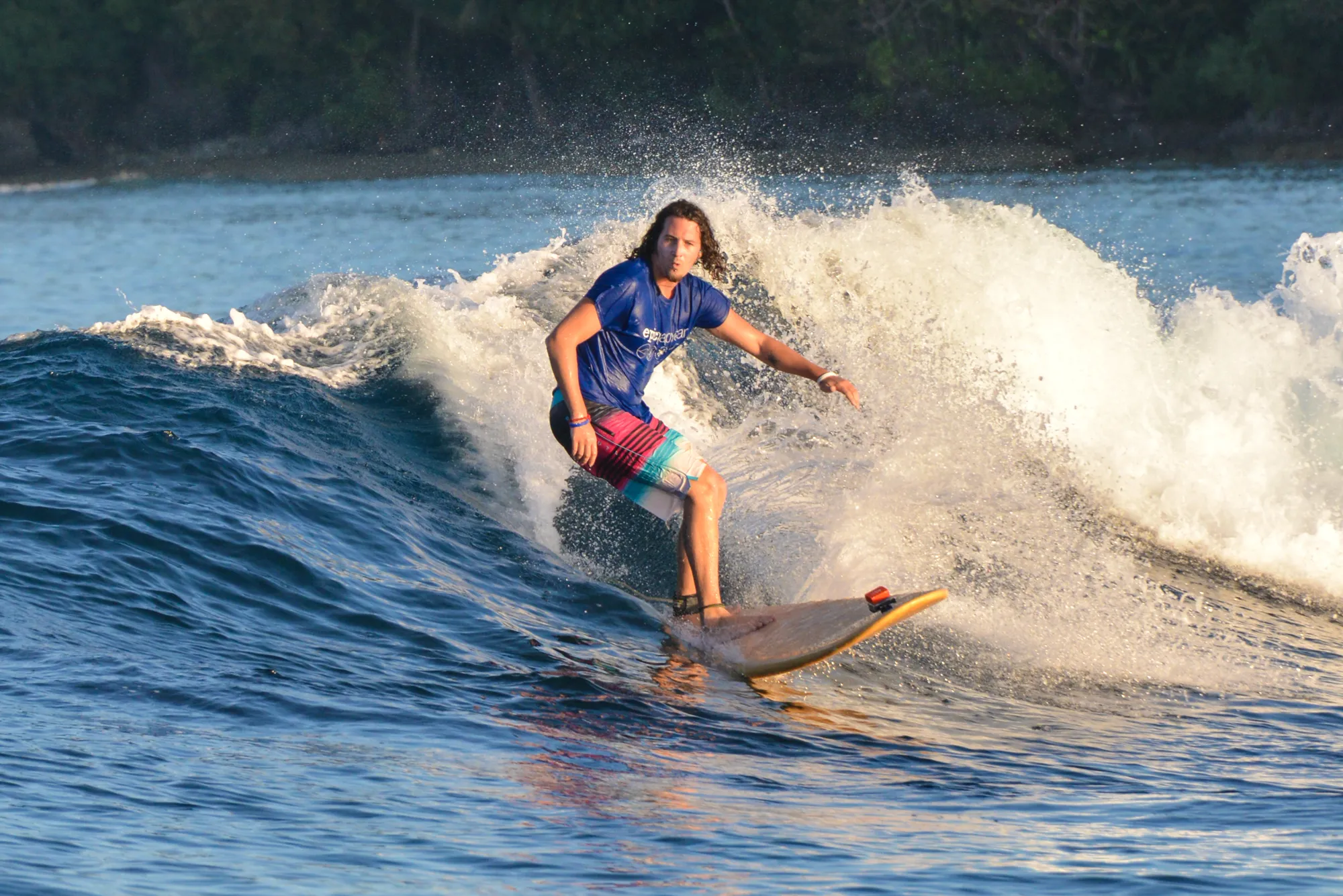
Siargao offers a surfing paradise for all levels, from beginners to experts.
- Type of Water: The surf spots in Siargao are primarily on the east coast, particularly around the General Luna and Cloud 9 areas, and consist of reef breaks.
- Swell and Wind: The swells when surfing Siargao in February are consistent, especially from October to April, aligning with the wet season in the Philippines. The swell height during January and February is approximately 8ft, with a swell consistency of 95%.
- Air Temperature: The air temperature in January and February is around 28°C (82°F).
- Water Temperature: The water temperature during these months is around 27°C (81°F), making it comfortable for surfing in light gear.
- Average Wave Size: The wave size varies across different surf spots. At Cloud 9, waves are typically at least chest-high and can reach double overhead during peak season. At Quicksilver, waves can also reach double overhead and are fast, suitable for experienced surfers.
-
Skill Level Requirements:
- Beginners: Spots like Jacking Horse and Daku Reef are ideal for beginners, offering manageable waves and a conducive learning environment.
- Intermediate Surfers: Spots like Rock Island, Cemetery, and the outer section of Jacking Horse provide a good challenge for intermediate surfers.
- Advanced/Expert Surfers: Cloud 9 is the most famous spot, suitable for expert surfers looking for a challenge with its hollow and powerful waves. Other spots like Quicksilver and Stimpy’s also offer advanced-level waves.
2. Barbados, South Coast
Barbados, with its South Coast surf spots, shines as one of the best surf destinations in February. This Caribbean paradise offers a vibrant surf scene, attracting surfers of all levels with its warm waters and consistent waves.
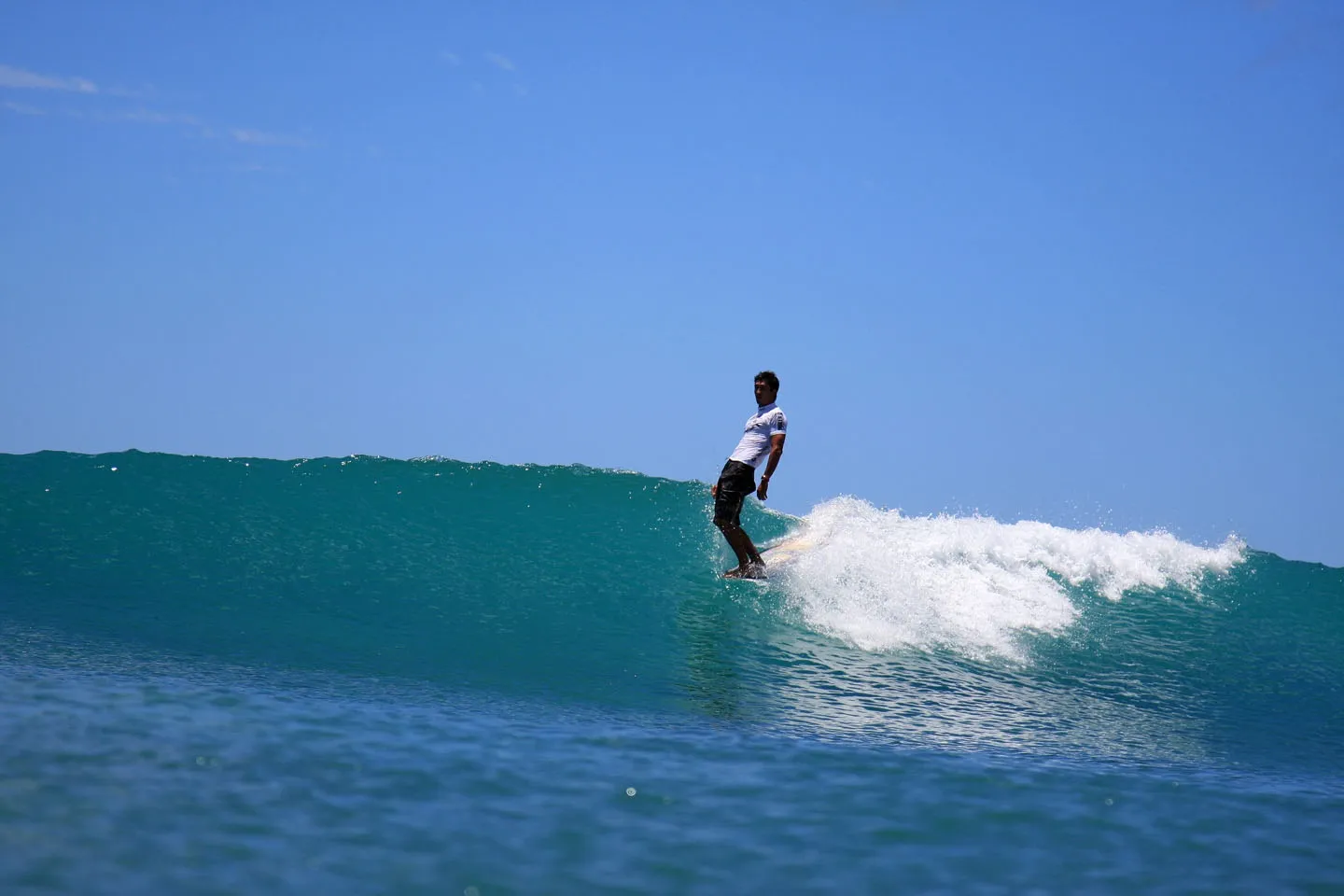
Whether you’re a beginner taking your first ride or an advanced surfer carving through challenging breaks, Barbados’ South Coast has something exhilarating for everyone during these prime surf months.
- Best Time to Surf: The peak surf season runs from November to March.
- Wave Consistency: While surfing Barbados in February, the waves are incredibly consistent throughout the year.
- Water Temperature: The water temperature varies, generally ranging from 26°C to 29°C. In February, the average water temperature is around 27°C (81°F).
- Air Temperature: The average air temperature around this time is approximately 26°C (79°F).
- Average Wave Size: The wave height in February averages around 2.1 feet but can reach 4 to 6 feet.
- Swell Consistency: The swell consistency in this period is about 80%.
- Skill Level Requirements: Suitable for beginner, intermediate, and advanced surfers.
3. Taghazout, Morocco
Taghazout in Morocco stands out as one of the best surf spots in February. Nestled along Morocco’s sun-kissed coast, this once sleepy fishing village has evolved into a vibrant surf hub. It’s the kind of place where the waves have a rhythm of their own, enticing surfers from all corners of the globe.
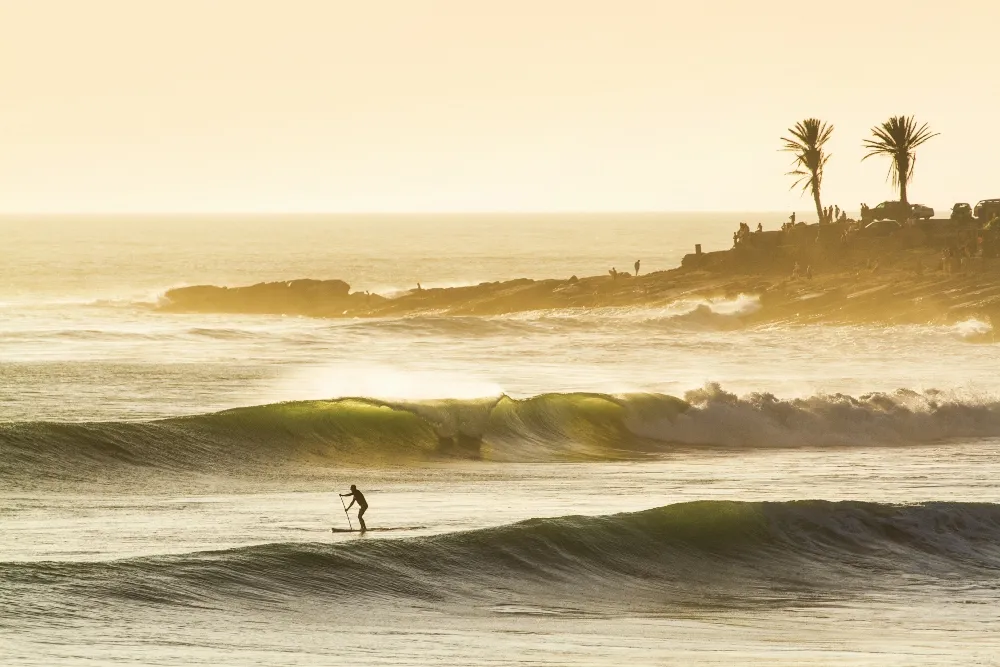
The Moroccan culture infuses every aspect of your surf experience, from the food to the local hospitality. In essence, Taghazout’s combination of diverse surfing conditions, welcoming culture, and scenic beauty make it a standout choice for surfers in February.
- Surf Season: The best waves roll in from October to April, with February offering some of the most impressive conditions. This time of year is a magnet for surfers looking for reliable swells under the Moroccan sun.
- Water Conditions: The water temperature when surfing in Morocco in February changes around 16°C (61°F). You’ll need a wetsuit, but the crisp waters are part of the charm.
- Air Temperature: The air is pleasantly cool, averaging around 14°C (57°F), a welcome contrast to the warmer water.
- Swell and Height: The swells are remarkably consistent at 95%, with heights that can reach up to 8 feet, offering thrilling rides for every surfer.
- Standout Surf Spots:
- Anchor Point: A legendary right-hand break, perfect for those with a bit more experience. Best on northwesterly swells at low tide.
- Boilers: Offering powerful right-hand waves over a shallow reef. It’s an adrenaline-pumping spot for intermediate and advanced surfers.
- Panoramas: More laid-back and suitable for beginners, this spot offers gentler right-hand waves.
- Killer Point: For the daring, this spot challenges with its robust right-handers.
4. Pichilemu, Chile
Pichilemu, Chile, is a standout surf destination, and is highly regarded as one of Chile’s best surf in February. Its popularity among surfers has grown significantly since it was first surfed in the early 1980s.
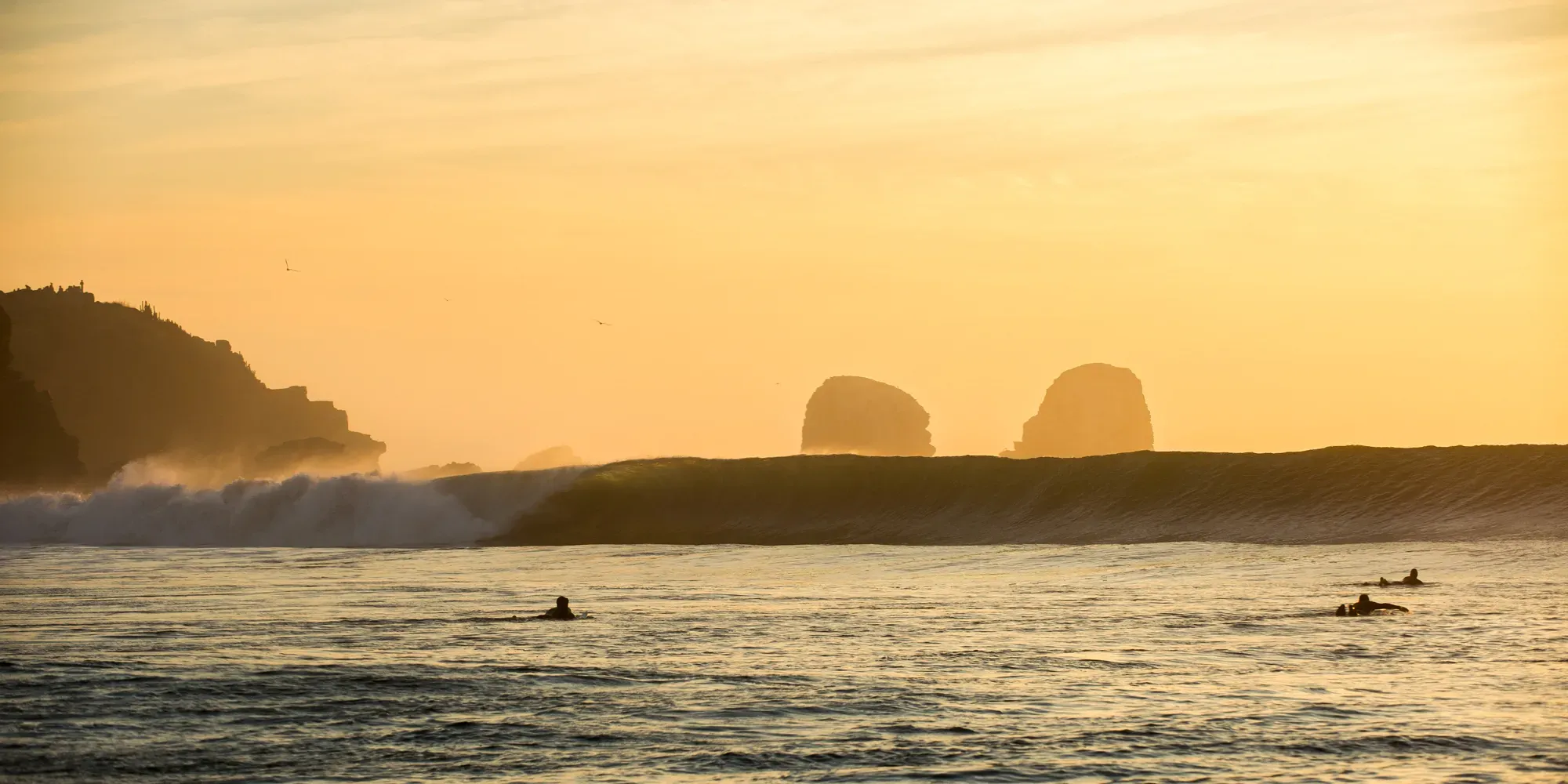
This small beach town, known for its left-hand breaks, offers a unique surfing experience backed by consistent swells from the South Pacific Ocean.
- Best Surfing Season: While Pichilemu offers good surf conditions throughout the year, December to February is the ideal time for warmer weather and mid-sized waves. During the rest of the year, the swells tend to be bigger, peaking in June and July.
- Water and Air Temperature: The water temperature ranges between 14°C (57°F) and 19°C (66°F), so surfers will need a wetsuit all year round. The air temperature during February is comfortably warm at around 22°C (72°F).
- Swell Conditions: The swells are consistent, rarely dropping below 3 feet, and flat days are almost nonexistent. Swell heights in February can reach around 7 feet.
-
Surf Spots: Pichilemu is home to several renowned surf spots:
- Punta de Lobos: Known for its world-class left-hand breaks, suitable for intermediate and advanced surfers.
- Infiernillo: Offers a fast and hollow left-hand wave, closer to town and ideal for advanced surfers.
- La Puntilla: Features Chile’s longest wave, a less consistent break but welcoming to surfers of all skill levels.
5. Nazare, Portugal
Nazare, Portugal, is renowned for its colossal waves, especially during the winter months, making it one of the best surfing in February. The small town once known mainly to Portuguese surfers, gained international fame after Garrett McNamara surfed record-breaking waves here.
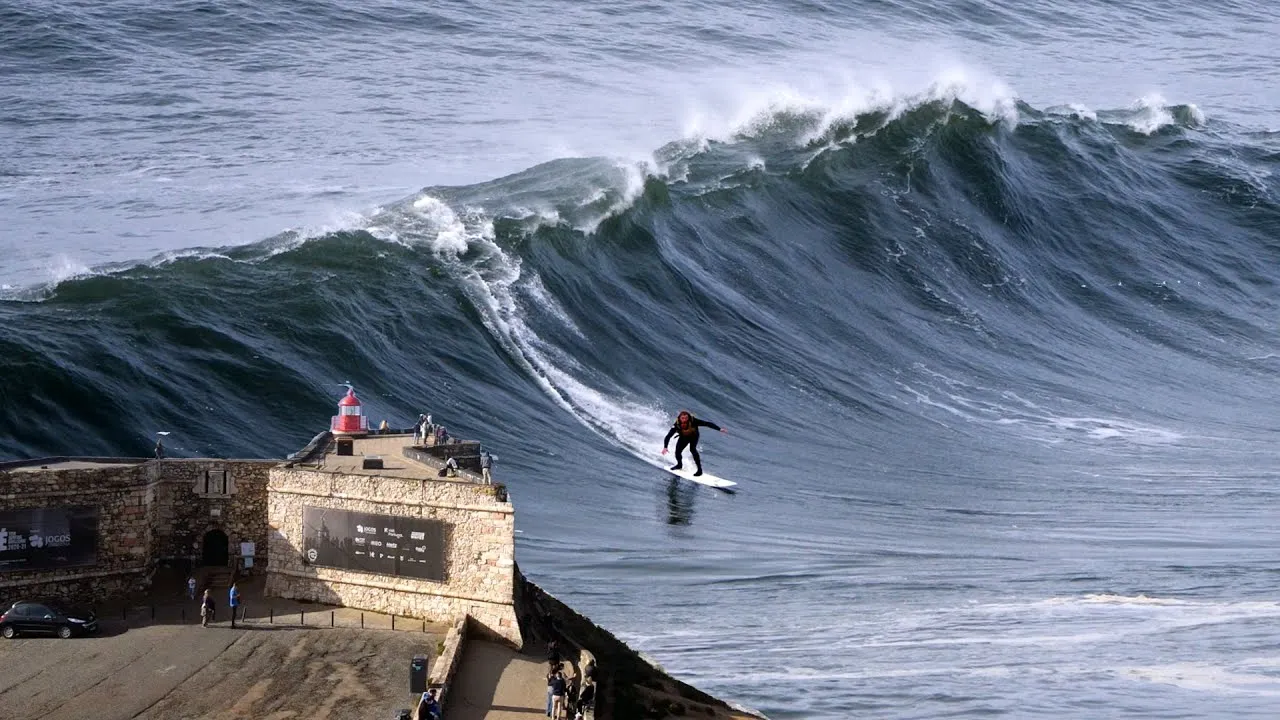
Nazare is now synonymous with big wave surfing, attracting thrill-seekers and spectators from around the world. Nazare, with its awe-inspiring waves and beautiful coastline, stands out as a premier destination for big wave surfing, especially in February. However, surfing here requires a high level of skill and experience due to the extreme nature of the waves.
- Optimal Surf Season: The prime time for big wave surfing in Nazare is from October to February. This period sees the Atlantic swells hitting the coast with full force, creating spectacular surfing conditions.
- Wave Conditions: The waves in Nazare are known for their immense size, often as tall as a 10-story building, thanks to the underwater canyon just off the coast. This canyon amplifies the power of the waves, making Nazare a hotspot for extreme surfing.
- Water and Air Temperature: The sea temperature in Nazare around this time is approximately 15.6°C. The air temperature, while cooler, complements the intense surfing experience.
- Swell and Wind: The swells are consistent and strong, with the most powerful waves expected to reach heights of about 2.4 meters. The wind conditions are typically cross-offshore, ideal for big-wave surfing.
Key Surf Spots:
- Praia do Norte: Famous for its gigantic waves and is the main attraction for big wave surfers. It’s suitable for the most experienced surfers due to its challenging conditions.
- Praia da Nazaré: Offers world-class surfing and bodyboarding for those not ready to tackle the giant waves of Praia do Norte. Equipment rental is available nearby, making it accessible for amateurs and pros alike.
6. Keramas, Bali
Keramas, nestled on Bali’s East Coast, truly comes alive as one of the best places to surf in February. Keramas offers a blend of great waves, beautiful scenery, and a unique surfing experience where it highlights its crisp right-handers, especially during the wet season when conditions align perfectly for surfers seeking a thrilling ride.
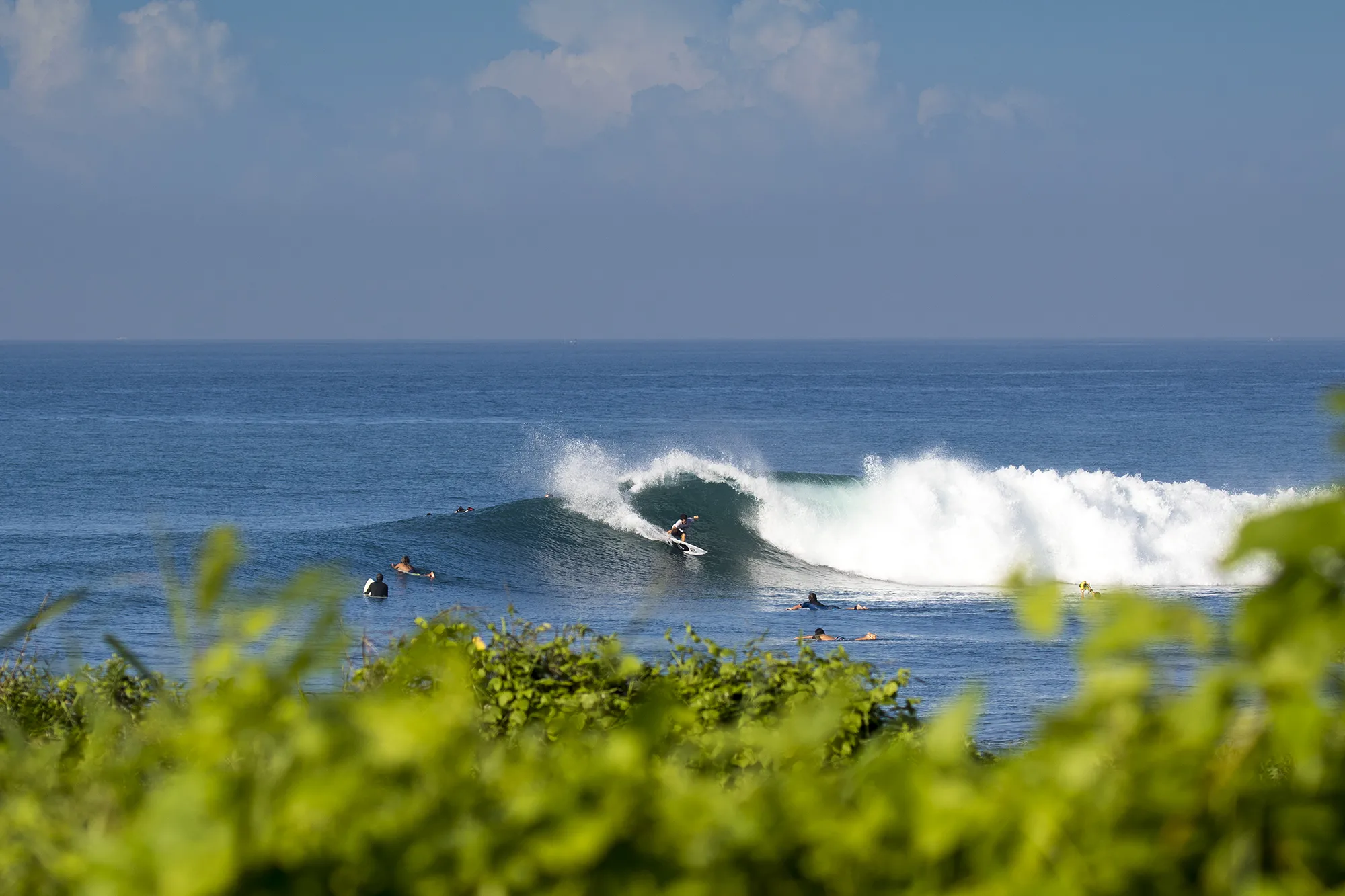
Surfing at Keramas:
- The Wave: Classic right-hand break. It’s a wave that offers everything from steep, challenging take-offs to exhilarating barrel sections. Surfers love it for its ability to transform from a deep hollow barrel into a long, ripable shoulder.
- Best Time to Surf: February falls right in the sweet spot of Keramas’ surf season. During Bali’s wet season, from November to March, the swells and winds conspire to create ideal surfing conditions.
- Tides and Conditions: Keramas is a bit tricky with tides. It’s generally recommended to surf here when the tide is rising to avoid the shallow reef.
7. Gold Coast, Australia
The Gold Coast in Australia is also the best place to surf in February and beauty extends to April. Known for its world-class surf spots, the Gold Coast becomes a hub for surfers during the cyclone season, bringing impressive ground swells to its shores. This period offers an excellent mix of wave conditions, attracting surfers of all levels.
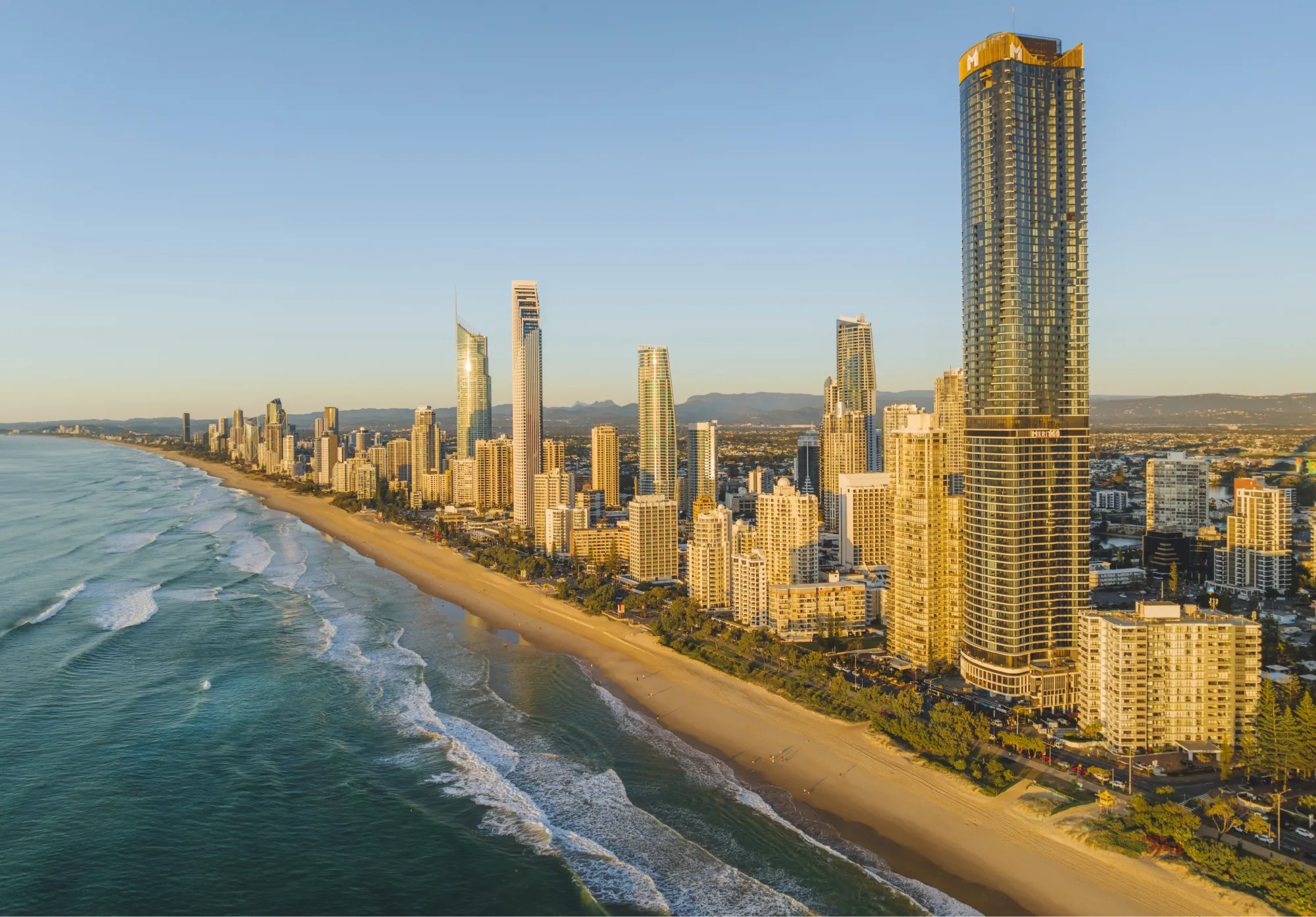
The Gold Coast’s reputation as a surfing paradise is well-earned, with its excellent surf conditions, beautiful beaches, and vibrant surf culture.
- Surfing Season: The best waves are typically seen from February to April, coinciding with the cyclone season. This time of year is characterized by favorable ground swells.
- Water and Air Temperatures: During this period, the water temperature is around 24°C (75°F), while the air temperature hovers at about 25°C (77°F).
- Swell Consistency and Height: Swell consistency is around 85%, with swell heights averaging around 6 feet. These conditions make it a reliable spot for quality surfing.
- Crowd Levels: The Gold Coast is quite popular, and beaches can get very crowded, especially during peak surfing times.
Key Surf Spots:
- Snapper Rocks: Known as one of Australia’s most iconic surf spots, Snapper Rocks is a right-hander that breaks over the Superbank, a man-made sandbar. It’s extremely consistent and suitable for all skill levels. On good days, the point break can connect all the way to Kirra.
- Duranbah Beach (Dbah): Offering both right and left waves, Duranbah Beach is suitable for surfers of all levels. It has a sandy bottom and is favored in southeast swells and west winds.
8. Rincon, Puerto Rico
Rincon, Puerto Rico, is a fantastic destination for beginner surfers looking for ideal conditions in February. Known for its scenic beauty and welcoming atmosphere, Rincon’s surf scene is diverse and accommodating for all skill levels, with a special appeal for beginners during this time of the year.
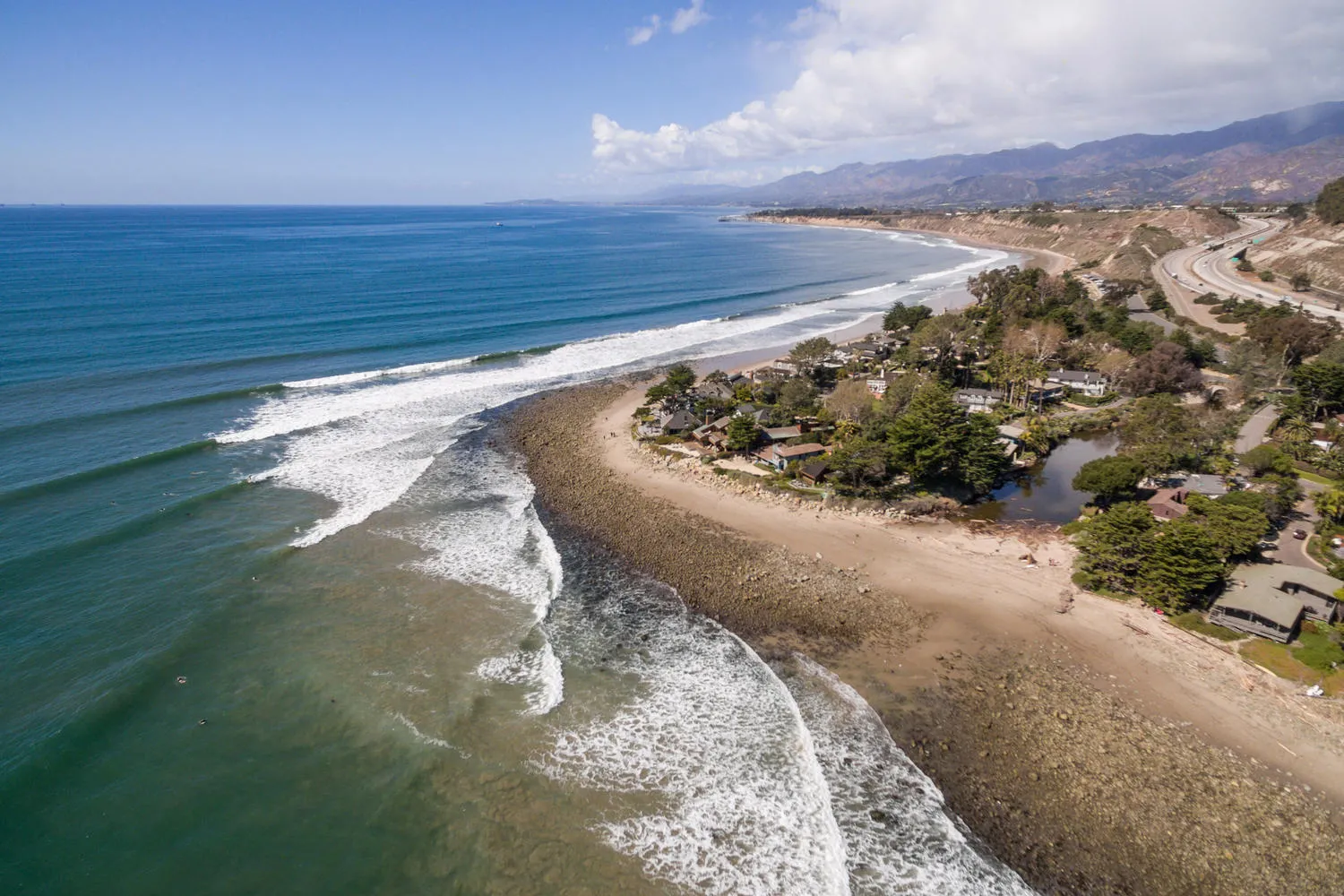
Rincon’s beautiful beaches, consistent waves, and a range of surf spots make it an ideal choice for beginners wondering where to surf in February. It’s a place where you can comfortably learn and enjoy surfing while soaking in the vibrant local culture.
Overview of Surfing in Rincon:
- Surf Season: Although Rincon is a year-round surf destination, February is particularly appealing. This month falls within the peak surf season, where you can find a mix of wave sizes suitable for different skill levels.
- Wave Conditions: Rincon offers a range of surf spots, from gentler waves ideal for beginners to more challenging ones for experienced surfers. Spots like Domes, Sandy, Parking Lot, and Rivermouth are noted for being beginner-friendly.
- Water Temperature: The water is warm, around 26°C (79°F).
- Swell Conditions: Average wave size of 4 to 6 feet, with 80% swell consistency.
9. Popoyo, Nicaragua
Popoyo in Nicaragua is a fantastic destination for surfers looking to catch some waves in February. This idyllic surf spot, located on Nicaragua’s Pacific coast, is known for its consistent waves and diverse surf breaks.
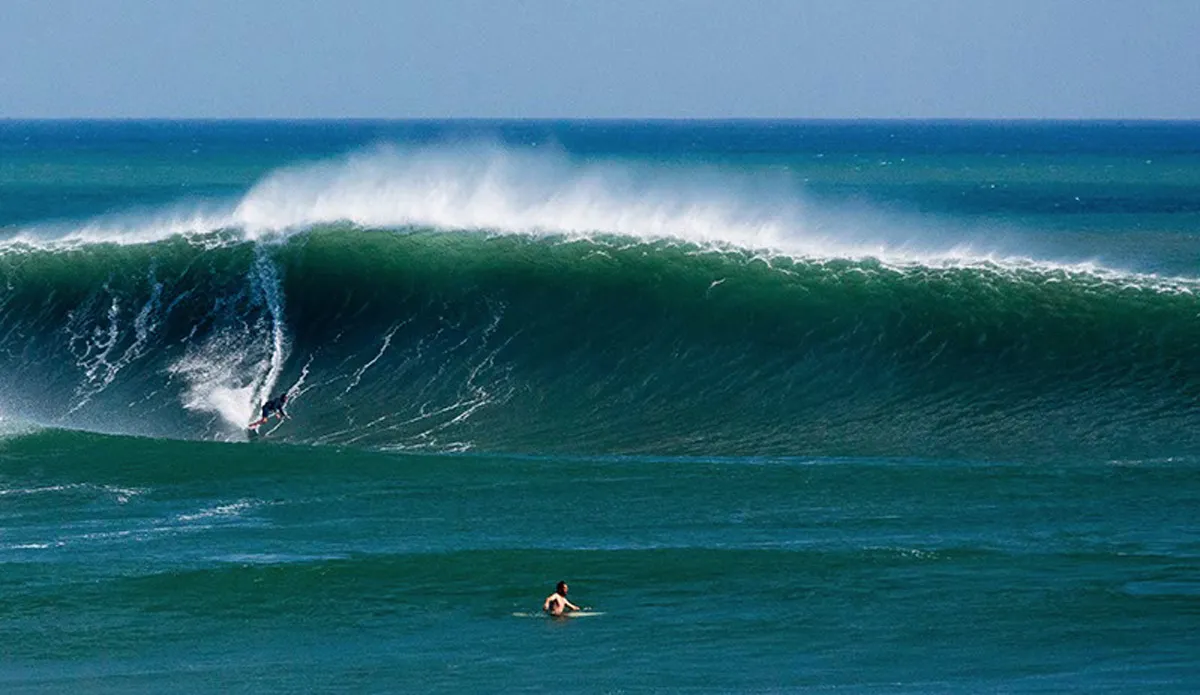
Popoyo stands out as a must-visit destination for surfing Nicaragua in February, with its warm waters, consistent waves, and variety of surf spots accommodating surfers of different skill levels. The welcoming vibe and beautiful scenery add to the overall surfing experience in this Nicaraguan paradise.
- Surf Season: While Popoyo is a year-round surf destination, the best time to surf here, especially for beginners, is during the dry season which includes February. During this time, the waves are typically smaller and more manageable.
- Wave Conditions: Average wave size of 2 to 4 feet, great for beginners and intermediates.
- Water and Air Temperatures: Both air and water temperatures hover around 27°C (81°F), providing comfortable conditions for surfing.
- Swell Conditions: The swells during February are moderate, offering conditions that are conducive for beginners and those looking to improve their skills.
Key Surf Spots:
- Popoyo Main Break: A consistent A-frame reef break suitable for intermediate and advanced surfers.
- Playa Guasacate: A beach break that is good for all skill levels and works best with smaller swells.
- La Lejana: A less crowded break near Popoyo, producing a long left with the right swells, suitable for all levels.
- Beginner Bay: As the name suggests, it’s ideal for beginners, offering soft and gentle waves over a rocky bottom.
10. Lombok, Indonesia
Surfing Indonesia in February calls out Lombok, the island, known for its stunning landscapes and crystal-clear waters, offers an array of surf spots suitable for different skill levels, making it a popular choice for those considering surfing in Indonesia during this month.
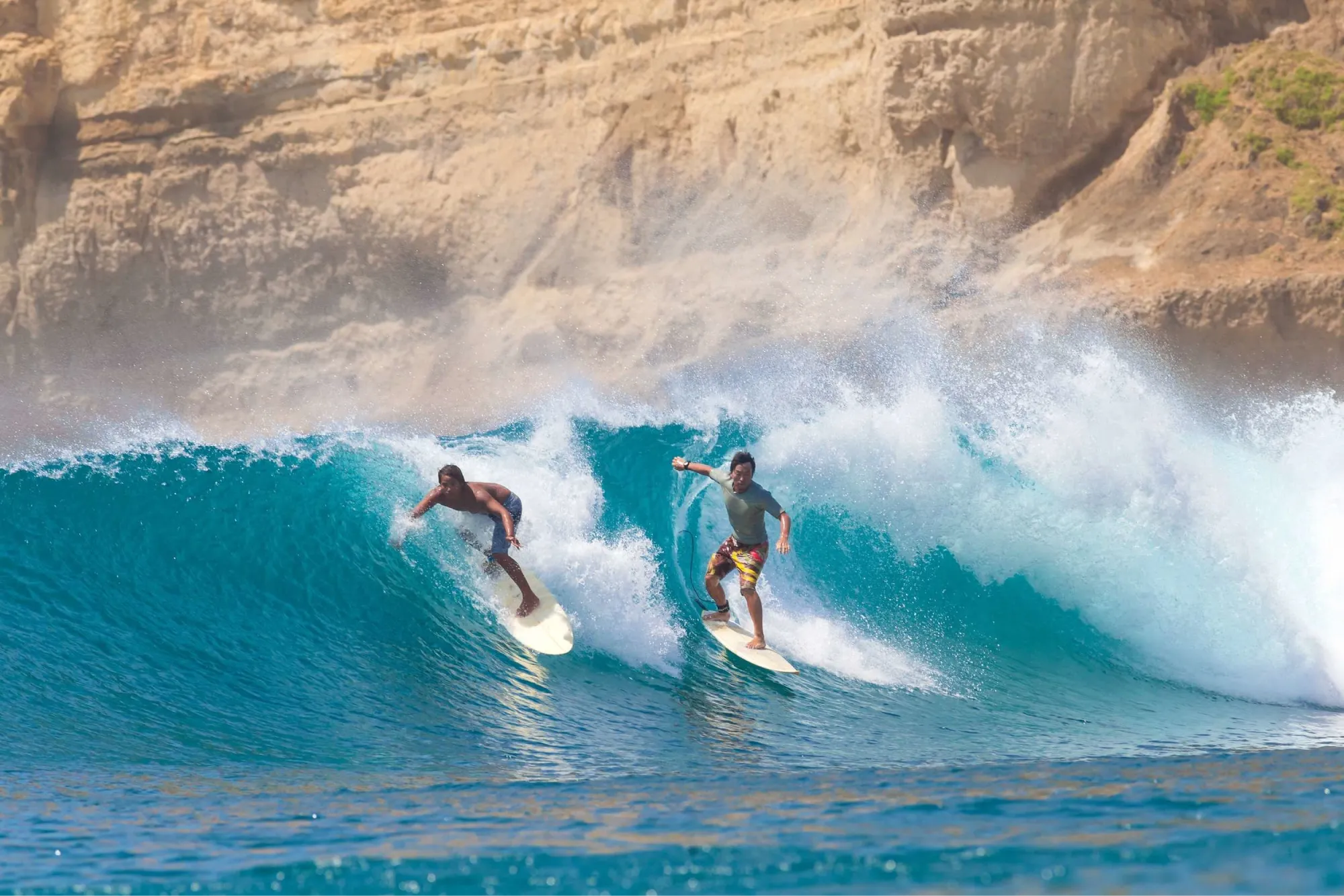
Surfing Overview in Lombok and Sumbawa:
- Surf Season: The surf in Lombok is consistent year-round, but the rainy season (October to April) is particularly favored for surfing. During this time, spots like Seger and Are Guling come alive with glassy waves and fewer crowds.
- Wave Conditions: Lombok is home to a variety of breaks, from beginner-friendly beaches to challenging reef breaks for advanced surfers. Spots like Selong Belanak are perfect for beginners, offering easy-going, sandy breaks. Intermediate surfers can enjoy spots like Are Guling, known for its right and left-hand waves, and Seger Reef, offering consistent waves. Advanced surfers can head to spots like Mawi, a renowned A-frame reef break.
- Water and Air Temperatures: The water temperature when surfing Lombok in February ranges between 26-30°C, providing warm conditions for surfers. The air temperature usually stays around 30-32°C during the day.
- Dry Season Surfing: The dry season (May – September) sees spots like Mawi and Desert Point working best, blessed with offshore winds and bigger swells.
Key Surf Spots:
- Selong Belanak: Ideal for beginners, offering a beautiful sandy beach break.
- Are Guling: Offers both a right and a left-hand wave, suitable for intermediate and advanced surfers.
- Seger Reef: Known for its fun and snappy waves, a short drive east of Kuta.
- Mawi: A consistent A-frame reef break, perfect in the dry season for experienced surfers.
- Ekas: Features two waves, Ekas Inside and Ekas Outside, catering to all levels.
11. Maui, Hawaii
Maui, Hawaii, is a renowned surfing destination that offers a diverse range of experiences for surfers of all skill levels, making it a top choice for those wondering where to surf in February beginner. The island’s unique geography creates a variety of breaks, including point breaks and beach breaks, ensuring that every surfer finds their perfect wave when surfing Maui in February.
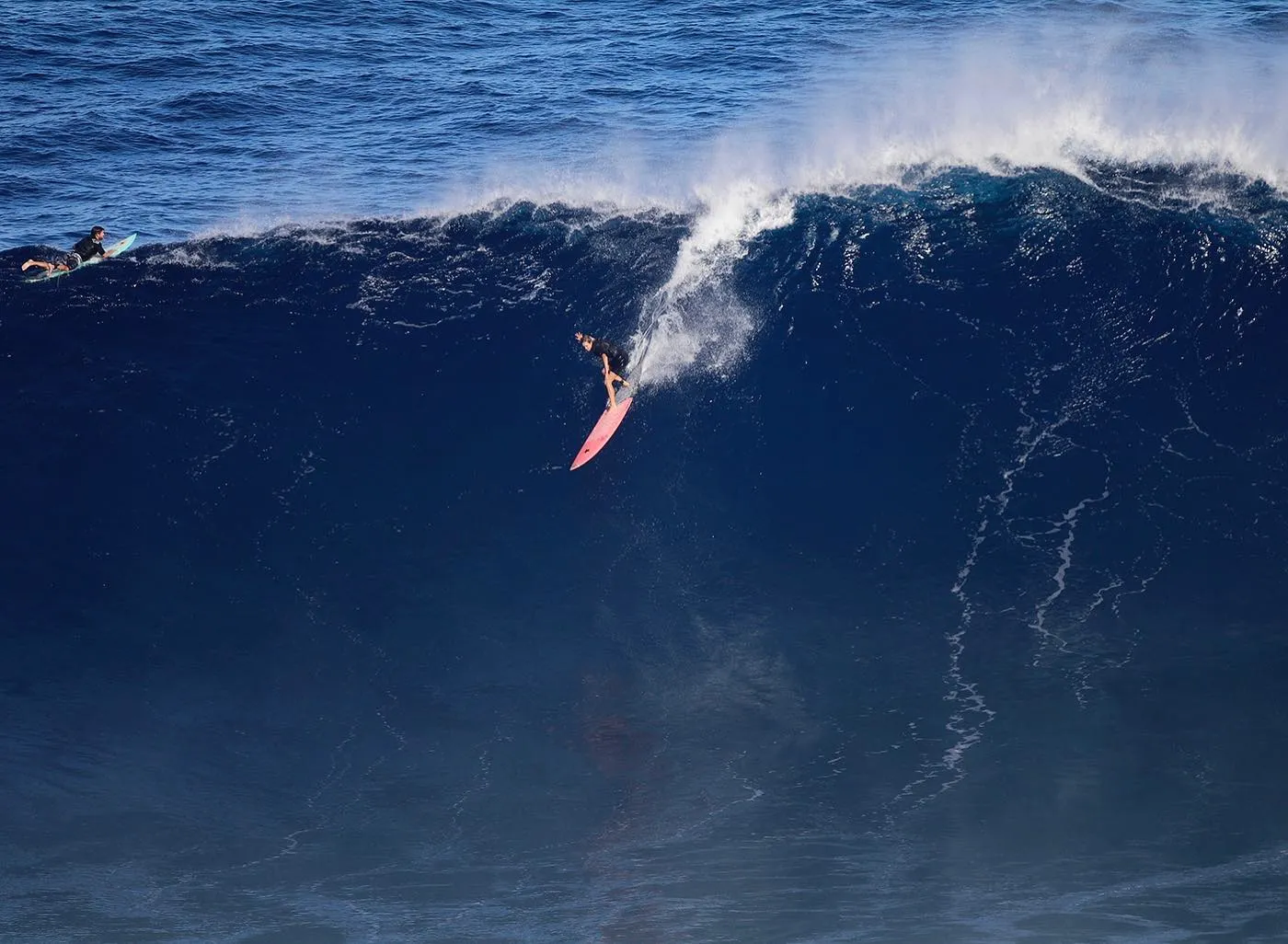
The surfing culture in Maui is deeply ingrained in the island’s history and traditions, making it more than just a sport; it’s a way of life. The local surf community is vibrant, and there are numerous surf schools and shops that can provide valuable information about the current conditions and help find the best spots for your skill level.
Overview of Surfing in Maui:
- Surf Season: Maui’s north shore experiences larger swells during the winter months, from November to February, attracting surfers worldwide. This period is ideal for those seeking challenging conditions and adrenaline-pumping rides at spots like Honolua Bay, Ho’okipa, and Pe’ahi (Jaws).
- Wave Conditions: Maui is known for its consistency in waves. It offers everything from gentle, rolling waves suitable for beginners to challenging reef breaks for advanced surfers. Locations like Honolua Bay provide long, glassy walls, while Jaws is famous for its massive waves.
- Water and Air Temperatures: The island enjoys warm tropical waters, making it comfortable for surfing without a wetsuit. The air temperature is also pleasant, contributing to a great overall surfing experience.
Key Surf Spots:
- Beginner Spots: Beaches like Kalama Beach Park in Kihei and Launiupoko Beach Park in Lahaina are ideal for beginners with their calm waters and forgiving waves.
- Experienced Surfer Spots: For more experienced surfers, Ho’okipa Beach on the north shore offers powerful swells and challenging surf breaks. Honolua Bay is another spot for experienced surfers, known for its massive waves and long rides.
12. San Diego, California
San Diego, California, emerges as a standout choice for surfing in February, offering a blend of challenging waves and pleasant weather conditions. This period is part of the winter season, which is considered the best time for surfing in the area due to consistent large waves.
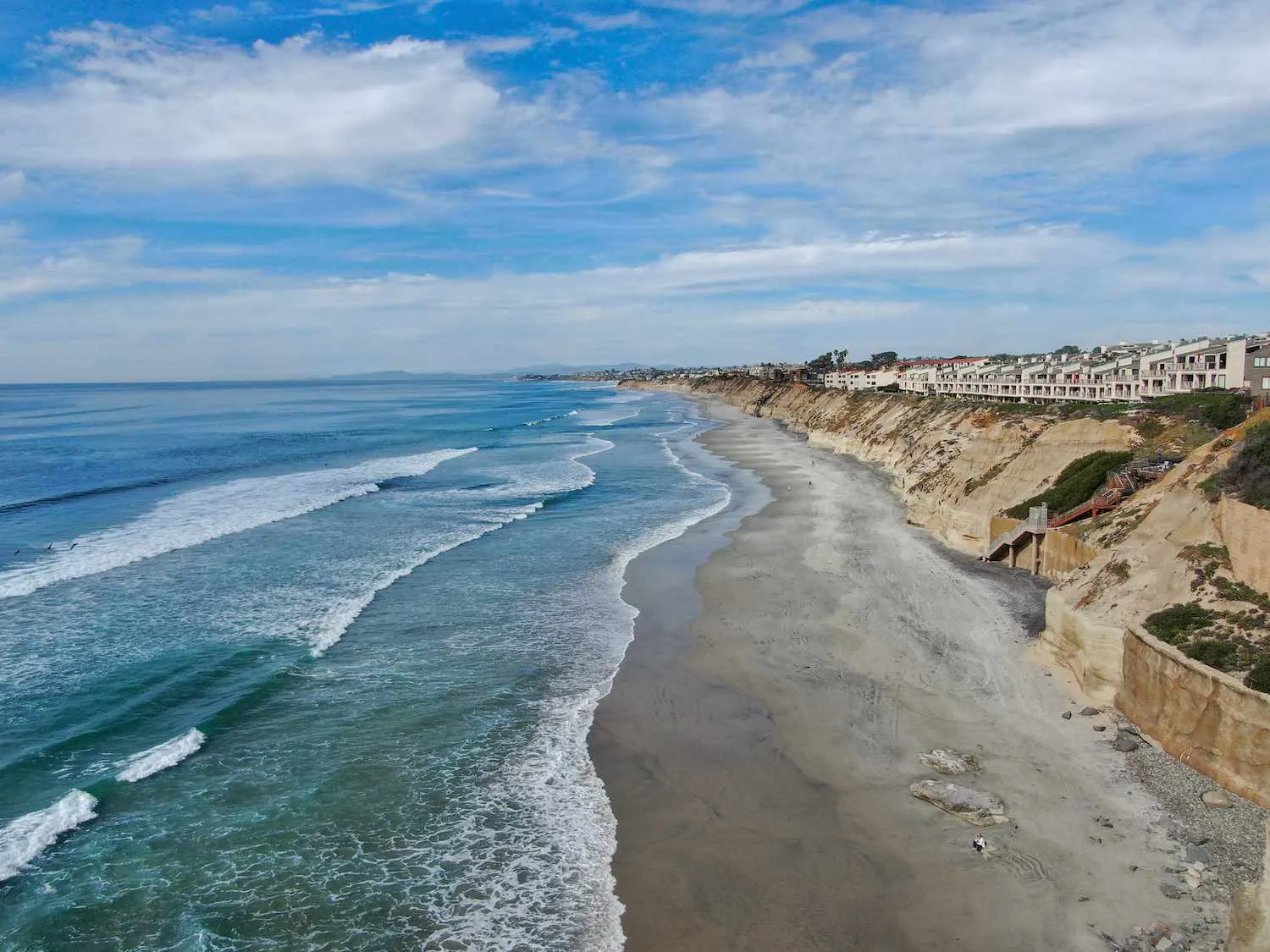
San Diego offers a great opportunity to enjoy diverse waves, whether you’re a beginner or an experienced surfer. The combination of consistent swells, mild temperatures, and a variety of surf spots makes it a favorable destination for surfing enthusiasts looking to catch waves while surfing in California in February.
Overview of Surfing in San Diego in February:
- Surf Season: The winter months, particularly February, see W + NW swells pounding the coast, creating consistently large surf. It’s common for some of the largest and heaviest waves to grace San Diego during this time.
- Wave Conditions: The waves in February are moderate to challenging, with the average wave size ranging from 2 to 8 feet. This variance provides a good balance between challenge and accessibility for surfers. Swell direction primarily originates from the north.
- Water and Air Temperatures: The water temperature in February ranges from the mid-50s to low 60s Fahrenheit, so a good wetsuit is essential. Air temperatures are mild and pleasant, hovering around the mid-60s to low 70s Fahrenheit.
Key Surf Spots in San Diego for February:
- Blacks Beach: Known for its large waves and challenging conditions, it is particularly suitable for experienced surfers.
- Sunset Cliffs: A popular spot that shines in the winter with consistent swell.
- Tourmaline Beach: Ideal for surfers of all skill levels and best recognized for longboarding.
- La Jolla Shores: A sandy beach break perfect for beginners and intermediate surfers, offering smaller and more forgiving waves.
13. Ericeira, Portugal
Surfing in Portugal in February is recognized as Europe’s only World Surfing Reserve, Ericeira boasts a variety of surf spots suitable for different skill levels. Its reputation as a surfing Mecca is well-deserved, offering year-round opportunities for an unforgettable surf experience.
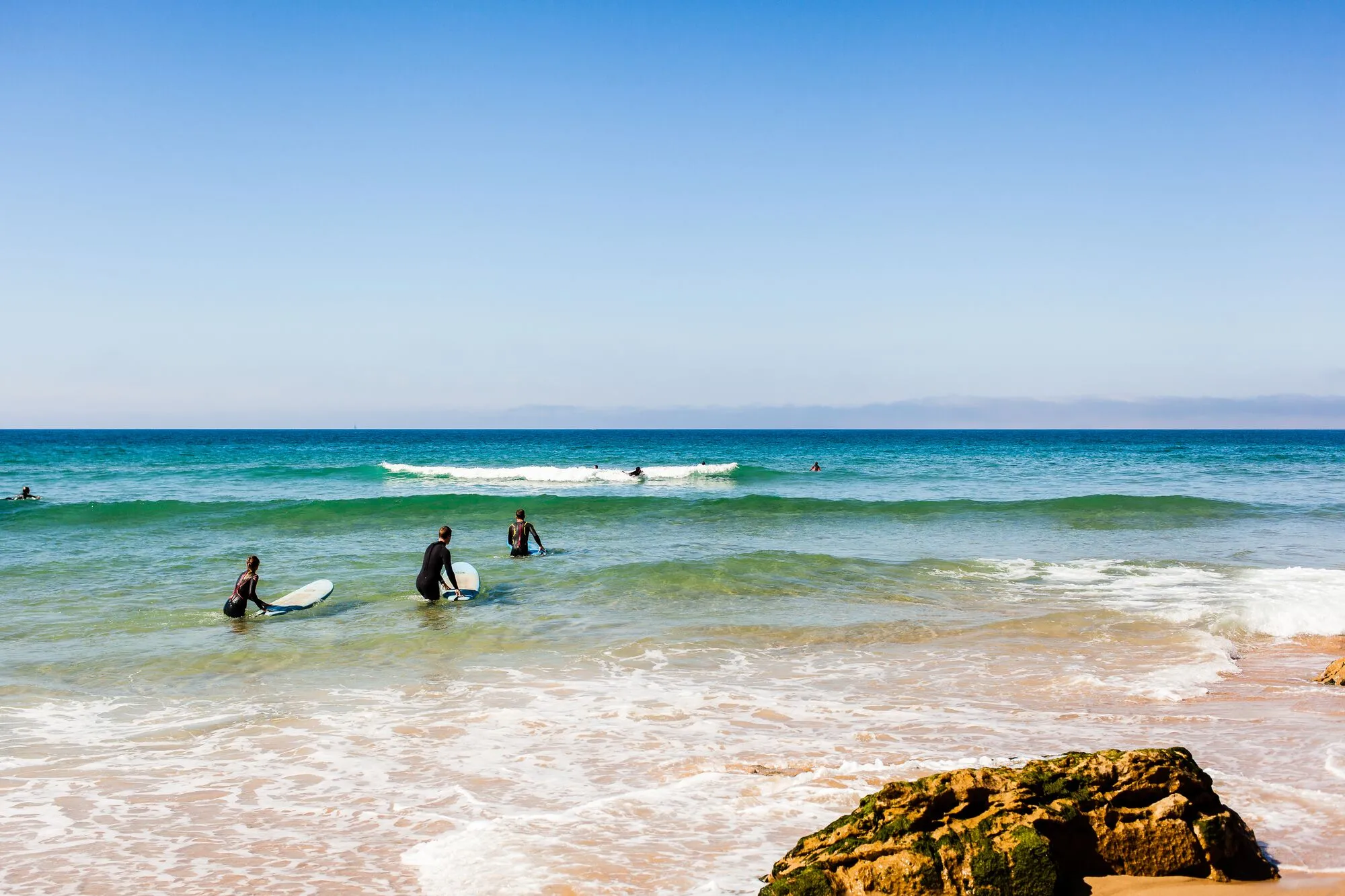
Ericeira’s combination of consistent surf, beautiful beaches, and a welcoming surf community make it an excellent choice for anyone looking to surf in Portugal in February. Whether you’re a beginner or an experienced surfer, the range of waves and the stunning natural scenery provide an ideal backdrop for an exciting surfing adventure.
Overview of Surfing in Ericeira:
- Surf Season: While you can surf in Ericeira all year round, the best months typically range from April to November. February, falling within this period, is no exception, offering good surfing conditions.
- Wave Conditions: Ericeira is renowned for its variety of beach breaks and reef breaks. The area is blessed with prevailing offshore winds and offers a diverse range of waves that cater to different surfing levels.
- Surf Spots: The region is dotted with surf spots for all levels. For beginners, spots like Foz do Lizandro and São Julião are ideal, providing gentler waves and a forgiving beach break. More experienced surfers can head to Ribeira D’Ilhas for its consistent waves, or challenge themselves at Coxos, known for its powerful right-hand reef breaks.
- Water Temperature: The water temperature in Ericeira during February can be quite cool, so a good wetsuit is essential for comfortable surfing sessions.
14. Tamarindo, Costa Rica
Tamarindo, Costa Rica, is a splendid surf destination, particularly in February, attracting surfers of various skill levels. This vibrant beach town, situated on Costa Rica’s Pacific coast, is known for its consistent surf, beautiful beaches, and lively atmosphere, making it an excellent choice for those looking to surf in February.
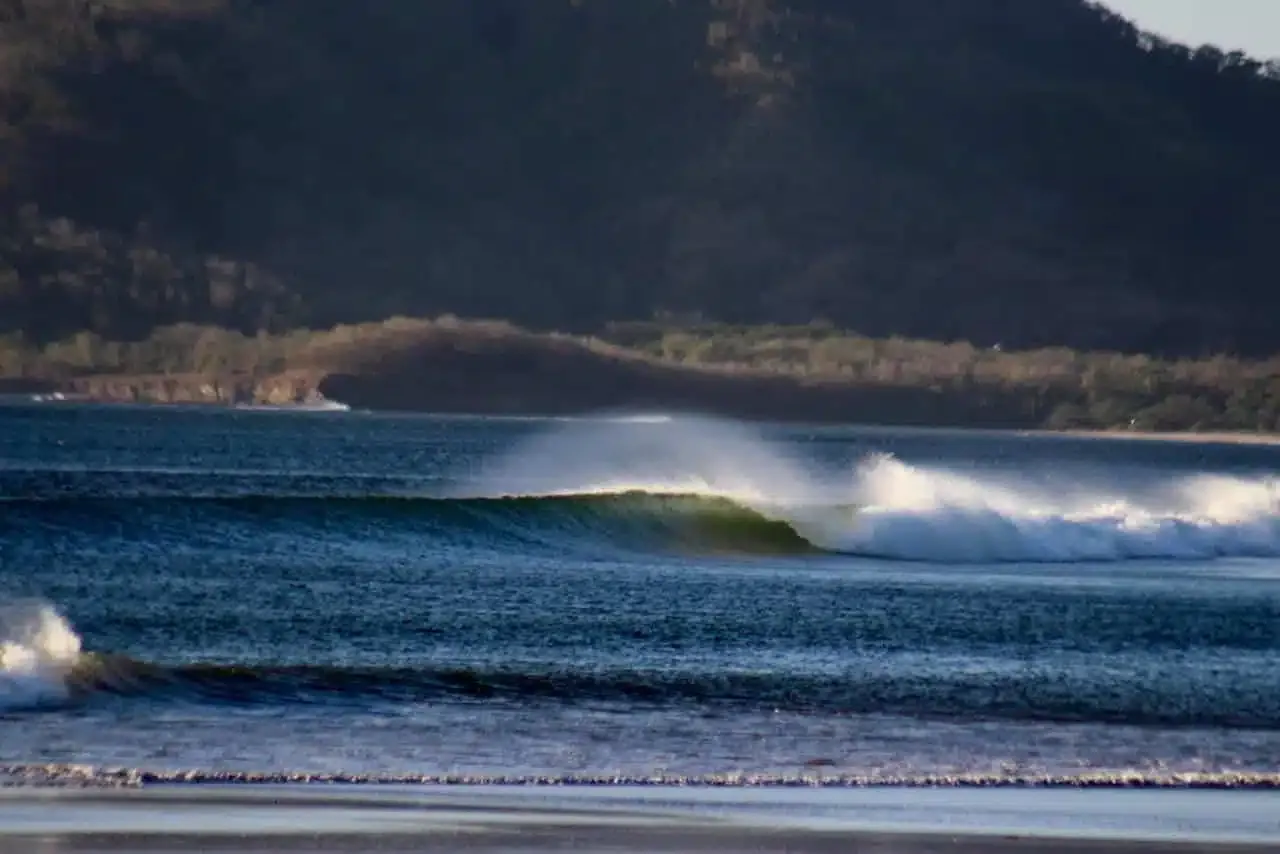
Tamarindo’s mix of accessible beaches, consistent waves, and the variety of surf spots make it an attractive place for Costa Rica surf in February. Whether you’re a beginner or an experienced surfer, the warm waters and vibrant local culture of Tamarindo offer an engaging surfing experience.
Surfing Overview in Tamarindo:
- Best Surfing Season: While Tamarindo is a year-round surf spot, December to April, including February, is considered the best time for surfing here. During these months, you can expect small to medium-sized waves with excellent conditions, ideal for beginner and intermediate surfers.
- Wave Conditions: Tamarindo’s main beach break offers gentle waves and a sandy bottom, perfect for beginners. For more experienced surfers, there are spots like Pico Grande and Pico Pequeno, known for their more challenging waves.
- Water and Air Temperatures: Both air and water temperatures in Tamarindo are warm and inviting, usually around 27°C (81°F), making it comfortable for surfing without a wetsuit.
- Tide and Wind: Surf conditions in Tamarindo are often best during an incoming mid-to-high tide. Offshore winds are common from December to March, grooming the incoming surf and creating excellent conditions.
Key Surf Spots in Tamarindo:
- Playa Tamarindo: Ideal for beginners, with its gentle waves and sandy bottom.
- Pico Pequeno and Pico Grande: Offer more challenging waves, suitable for intermediate and advanced surfers. These spots are known for their powerful breaks and are best surfed at high tide.
- Playa Grande: Located north of Tamarindo, it’s a great spot for surfers of all levels, with long rides and deep barrels.
- Witches Rock: A popular spot for beginners, offering easy waves ideal for learning.
- Avellanas: Suitable for beginners on small wave days and more experienced surfers when the waves are bigger.
15. Puerto Escondido, Mexico
Surfing Mexico in February – Puerto Escondido, is a prominent surf destination, especially renowned for its challenging waves, making it a favorite for surfers during February. This area is known for its heavy beach breaks, particularly at Playa Zicatela, often referred to as the Mexican Pipeline due to its powerful and barreling waves.
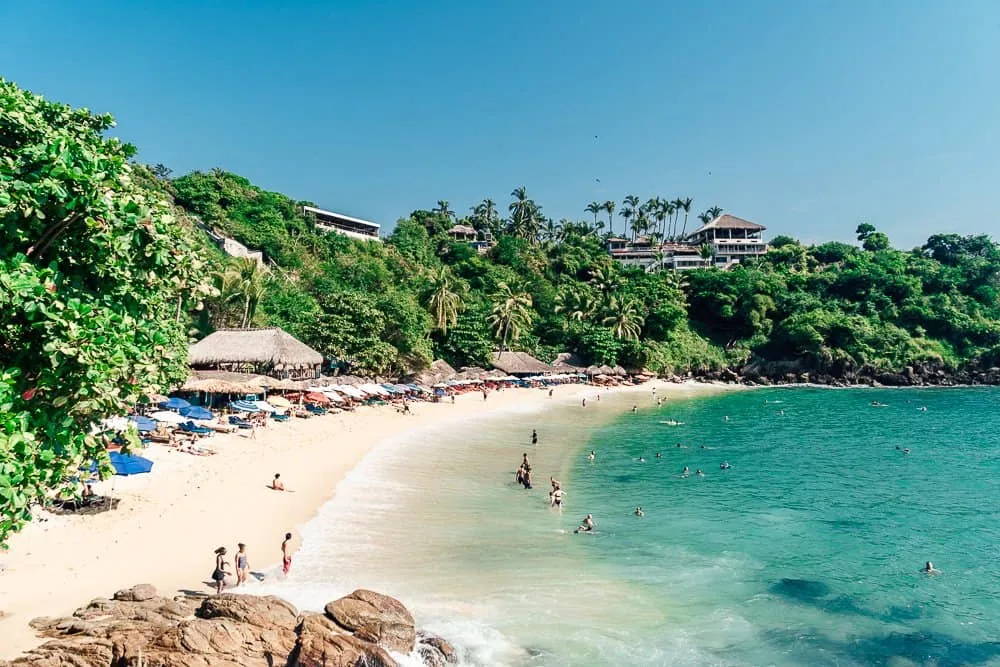
These conditions make Puerto Escondido a magnet for professional big wave surfers, especially during the summer months when the waves reach their peak.
Overview of Surfing in Puerto Escondido:
- Surf Season: The best time for surfing in Puerto Escondido varies depending on the surfer’s skill level. November to April tends to be better for beginners, offering smoother waves, while May to October brings larger waves and more challenging conditions.
- Wave Conditions: Puerto Escondido has a range of surf spots catering to different skill levels. Playa Zicatela, with its powerful beach breaks, is suited for advanced surfers. La Punta, offering left breaks, is more appropriate for intermediate surfers. For beginners who excited to surfing in Mexico in February, Playa Carrizalillo provides smaller, more manageable waves.
- Water and Air Temperatures: The water temperature in Puerto Escondido during February is around 27°C (81°F), and the air temperature averages 26°C (79°F).
Key Surf Spots in Puerto Escondido:
- Playa Zicatela: Known for its massive waves, suitable only for experienced surfers.
- La Punta: Offers a left-hand point break, less intense than Zicatela but still challenging, ideal for intermediate surfers.
- Playa Carrizalillo: The best spot for beginners with mellow waves, perfect for learning and practicing.
Maybe you’ll interested in: 13 Best Places to Surf in March
Surfing in February with Boost Fin
February is the month when the surf world comes alive with some of the best waves you can find. From the challenging barrels of Nazare, Portugal, to the serene waters of Tamarindo, Costa Rica, there’s a perfect wave for every surfer.
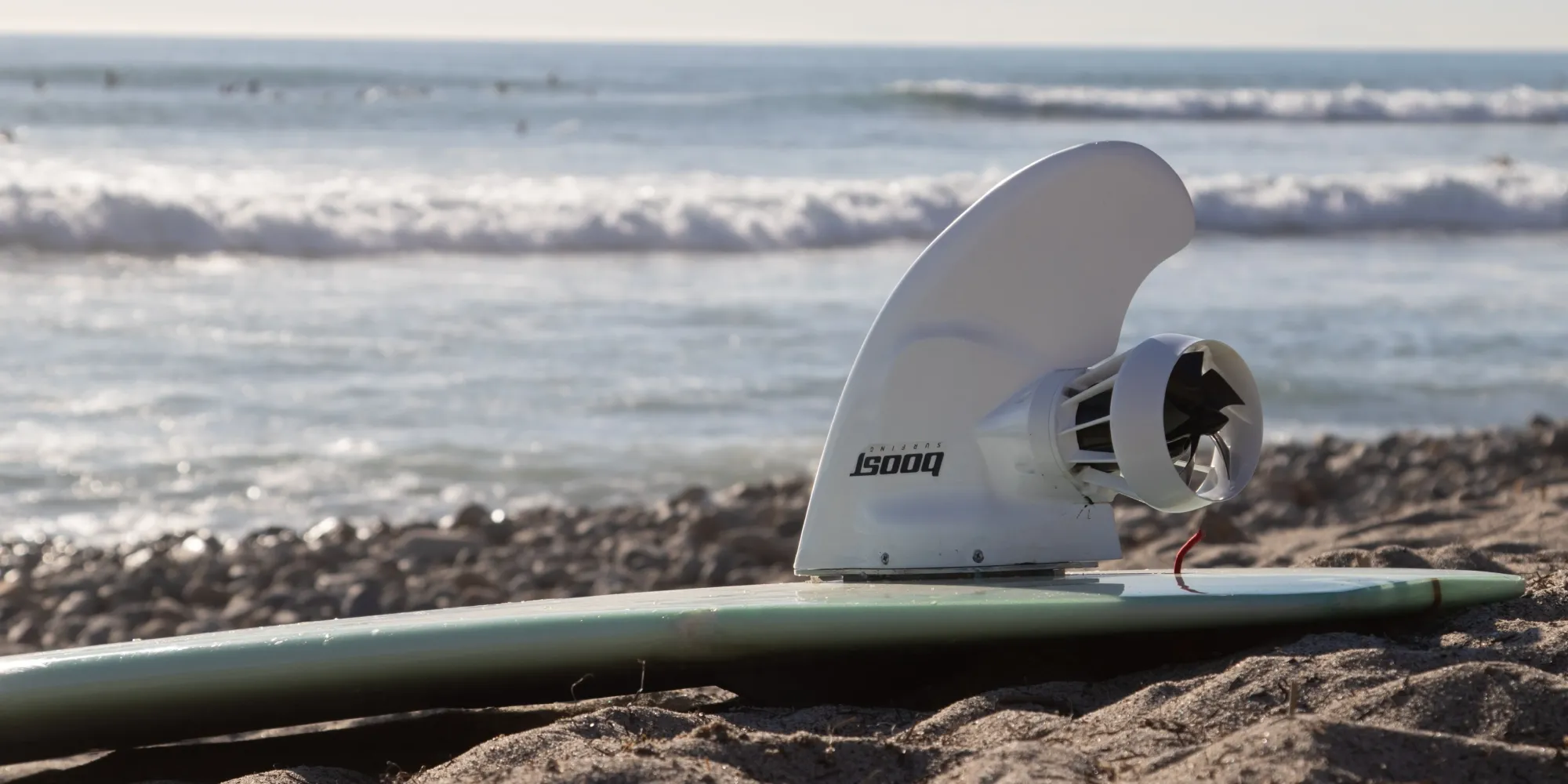
Boost Fin brings a dynamic change to surfing at the best places to surf in February. Easily attachable to any surfboard, it boosts speed up to 10 mph and has a 60-90 minute battery life for longer, more efficient sessions.
When buying the Boost Fin, beware of imitations since authentic Boost Fin products are available exclusively through the official Boost Surfing website and select authorized distributors, where the product meets the high standards of Boost Surfing.
So, as you plan your February surf trip to some of the world’s best surfing spots, think about upgrading your ride with the genuine Boost Fin.


Compartilhar:
Malibu Surfing Guide: 12 Best Surf Spots
13 Best Places to Surf in March